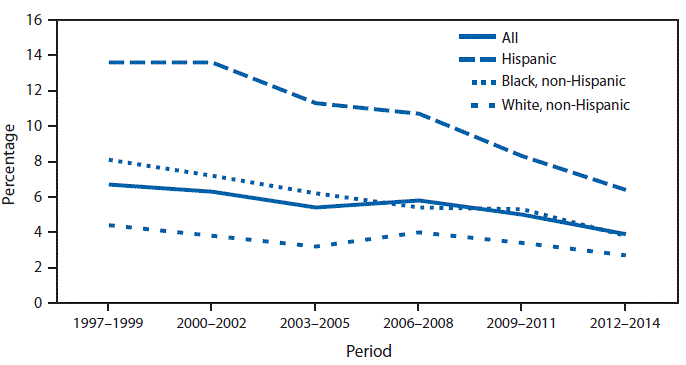QuickStats: Percentage of Children and Adolescents Aged 0–17 Years with No Usual Place of Health Care,* by Race† and Hispanic Ethnicity — National Health Interview Survey, United States, 1997–2014§

* Children and adolescents were defined as having no usual place of health care if a knowledgeable adult answered "no" to the question ''Is there a place that the child goes when he or she is sick or you need advice about his or her health?" or answered "yes" and responded "emergency room" to the question, "What kind of place (do you go to most often): a clinic, doctor's office, emergency room, or some other place?"
† All indicates persons of all races and ethnicities, not just those shown separately.
§ Estimates were derived from the National Health Interview Survey sample child component, based on household interviews with a national sample of the civilian, noninstitutionalized U.S. population.
During 2012–2014, 3.9% of children and adolescents aged 0–17 years had no usual place of health care compared with 6.7% during 1997–1999. From 1997–1999 to 2012–2014 the percentage of children and adolescents with no usual place of care declined for Hispanics (from 13.6% to 6.4%) and non-Hispanic blacks (from 8.1% to 3.8%). The change for non-Hispanic whites from 4.4% during 1997–1999 to 2.7% during 2012–2014 was not statistically significant. Hispanic children and adolescents were more likely than non-Hispanic white or non-Hispanic black children and adolescents to have no usual place of health care during 1997–2014.
Sources: National Health Interview Survey. Available at http://www.cdc.gov/nchs/nhis.htm. CDC. Health data interactive. Available at http://www.cdc.gov/nchs/hdi.htm.
Reported by: Ellen A. Kramarow, PhD, ekramarow@cdc.gov, 301-458-4325; Yelena Gorina, MS, MPH.
Alternate Text: The figure above is a line chart showing that during 2012-2014, 3.9% of children and adolescents aged 0-17 years had no usual place of health care compared with 6.7% during 1997-1999. From 1997-1999 to 2012-2014 the percentage of children and adolescents with no usual place of care declined for Hispanics (from 13.6% to 6.4%) and non-Hispanic blacks (from 8.1% to 3.8%). The change for non-Hispanic whites from 4.4% during 1997-1999 to 2.7% during 2012-2014 was not statistically significant. Hispanic children and adolescents were more likely than non-Hispanic white or non-Hispanic black children and adolescents to have no usual place of health care during 1997-2014.
Use of trade names and commercial sources is for identification only and does not imply endorsement by the U.S. Department of
Health and Human Services.
References to non-CDC sites on the Internet are
provided as a service to MMWR readers and do not constitute or imply
endorsement of these organizations or their programs by CDC or the U.S.
Department of Health and Human Services. CDC is not responsible for the content
of pages found at these sites. URL addresses listed in MMWR were current as of
the date of publication.
All MMWR HTML versions of articles are electronic conversions from typeset documents.
This conversion might result in character translation or format errors in the HTML version.
Users are referred to the electronic PDF version (http://www.cdc.gov/mmwr)
and/or the original MMWR paper copy for printable versions of official text, figures, and tables.
An original paper copy of this issue can be obtained from the Superintendent of Documents, U.S.
Government Printing Office (GPO), Washington, DC 20402-9371;
telephone: (202) 512-1800. Contact GPO for current prices.
**Questions or messages regarding errors in formatting should be addressed to
mmwrq@cdc.gov.


